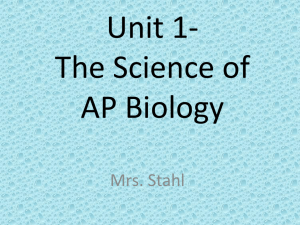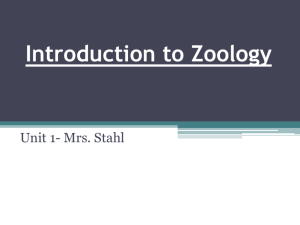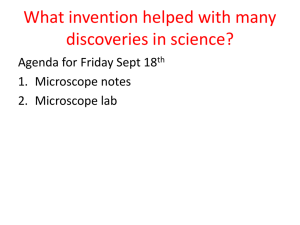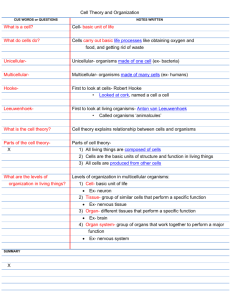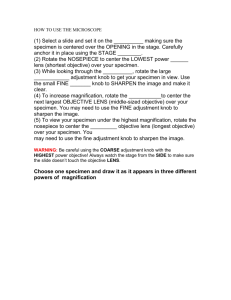Introduction to Zoology
advertisement
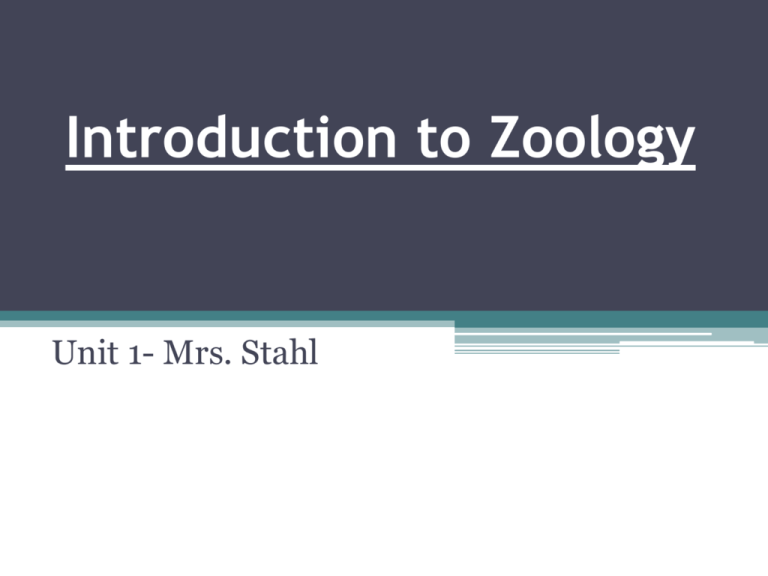
Introduction to Zoology Unit 1- Mrs. Stahl Zoology- What is it? • The study of animals of course! • Extremely broad because there are so many concentrations and sooooo many animals. • There are 8.7 million organisms on Earth, only 1.7 millions have been described. • Only 14% of the worlds species have been identified- that leave 86% left • Only 9% of the oceans species have been identified. ▫ Ex- 20,000 species of bony fish ▫ Ex- 300,000 species of beetles Category Species Totals Vertebrate Animals Mammals Birds Reptiles Amphibians Fishes 5,490 9,998 9,084 6,433 31,300 Total Vertebrates 62,305 Invertebrate Animals Insects 1,000,000 Spiders and scorpions 102,248 Molluscs Crustaceans Corals Others 85,000 47,000 2,175 68,827 Total Invertebrates 1,305,250 Plants Flowering plants (angiosperms) 281,821 Conifers (gymnosperms) 1,021 Ferns and horsetails 12,000 Mosses 16,236 Red and green algae 10,134 Total Plants Others Lichens Mushrooms Brown algae Total Others TOTAL SPECIES 321,212 17,000 31,496 3,067 51,563 1,740,330 What is an animal??????????????? • A living organism that feeds on organic matter, typically having specialized sense organs and nervous system and able to respond rapidly. Why do we want to study animals? So we can study their: - Functionality - Structure - Ecological Role and Importance - Evolution Kingdom Animalia • • • • • Multicellular Eukaryotic Consumers / Heterotrophs Specialized Tissues- various tissues and organs Aerobic Respiration / Cellular Respirationmetabolically break down food and use ATP energy to drive all of their functions. • Sexual Reproduction • Mobility Characteristics of Animals • Originated in the Precambrian Era over 600 mya. • Eukaryotes- organisms whose cells contain a nucleus. • Includes Plants, Fungi, and some unicellular organisms. • Animals -unique in nutrition; they eat other organisms and therefore need to capture food. • Animals lack photosynthesis; cell walls found in plants. • Fungi absorb food through little tubular filaments called hyphae which animals do not have. Some are neither plants nor animals…. • Euglena- motile, single celled organism that resembles plants in that they can be photosynthetic but also resembles animals in that they eat food particles. • Kingdom Protista. Animals also….. • Motile- move about from one location to the next. • Sessile- Cannot move from place to place but they still have moving parts. • What are 5 animals that are sessile and 5 that are motile? • Respiration • Digestion • Ingestion Sessile Motile How are they classified???? • Carl Linnaeus (1707-1778) • He came up with a means of naming organisms that was simple and universal. • Problem before this was that people were naming things multiple names that were really long, and there wasn’t any consistency. • Taxonomy- science of classifying organisms and assigning each organism a universally accepted name. • Linnaeus came up with binomial nomenclature-> two word naming system ▫ ▫ ▫ ▫ Genus, species Always in italics Genus is capitalized and species lowercased Ex- Homo sapiens Classification System • • • • • • • Kingdom Phylum Class Order Family Genus Species King Phillip Came Over From Great Spain!!!! Three Domains & Six Major Kingdoms Domains • Bacteria-> contains single celled prokarotes. Largest group on Earth. • Archaea-> Microbes that live in extreme environments • Eukarya-> organisms with compartmentalized cells, eukaryotic cells. Kingdoms • • • • Animalia- Animals Plantae- Plants Fungi- Fungus Protista- animal like and plant like • Bacteria • Archaea Class Agnatha Chondrichthyes Osteichthyes Amphibia Reptila Aves Mammalia Two Major Categories • Vertebrates- with a backbone • Invertebrates- without a backbone • What am I? Comparison • Vertebrates ▫ Internal segmented backbone ▫ Most obvious ▫ Make up less than 5 % of animal species • Invertebrates ▫ Without backbone ▫ Closely related to each other ▫ About 95% of all animals are inverts. Taxonomy- How it’s broken down! • Kingdom Animalia • Phylum Chordata • Class: ▫ ▫ ▫ ▫ ▫ ▫ ▫ Agnatha= Lampreys Chondrichthyes=Sharks and Rays Osteichthyes= Bony Fish Amphibia= Frogs and Salamanders Reptilia=Reptiles Aves=Birds Mammalia=Mammals Vertebrate facts and Characteristics • • • • • • • • More than one million species of animals. Tens of millions undiscovered Specialized tissues and organs Found EVERYWHERE!!! Have a backbone or vertebrate column Have a skull or cranium An internal skeleton Range in size. Largest being the blue whale. Seven Essential Functions to all Vertebrates • 1. Feeding▫ ▫ ▫ ▫ ▫ ▫ Herbivore- eats plants Carnivore- eats meat Omnivore- eats both plants and animals Detritivore- feeds on dead things Filter Feeders- strain food from the water Parasite- lives on or in another organism. • 2. Respiration- takes in oxygen, gives off carbon dioxide. Can be done through gills, lungs, skin, diffusion • 3. Circulation- circulating of blood through vessels. • 4. Excretion- primary waste is ammonia. Liquid waste filtered by the kidneys. • 5. Response- receptor cells= sound, light, external stimuli • 6. Movement- most are motile and the muscles work with skeleton • 7. Reproduction- most sexually= genetic diversity. Let’s Narrow it down a little…. • • • • • • Ichthyology- Study of fish Entomology- insects Herpetology- amphibians & reptiles Mammalogy- mammals Ornithology- birds Protozoology- Protozoa Let’s Review a little….. • All living things must be able to: ▫ ▫ ▫ ▫ ▫ ▫ ▫ ▫ ▫ 1. Reproduce 2. Made up of cells 3. Respond to a stimulus 4. Grow and develop 5. Evolve and change 6. Metabolize- need and use chemical energy 7. Maintain Homeostasis 8. Be made up of DNA 9. Chemical Uniqueness Made up of Cells • Smallest and basic unit of life. • Each level builds on the level below it. • Ex- within a cell macromolecules are assembled into ribosome's, chromosomes, and membranes and they are then built upon to form organelles such as the mitochondria. Continues on to populations and species. DNA- Deoxyribonucleic acid • Stores genetic information • Made up of nucleotides (4 nitrogenous base pairs-AGCT), sugars, and phosphates. • Adenine (A) pairs up with Thymine (T) • Guanine (G) pairs up with Cytosine (C) • The sequence of the bases is what codes for the order of amino acids in the protein sequence (amino acids). Chemical Uniqueness • Complex molecular organization • Macromolecules- Proteins, Lipids, Carbohydrates, and Nucleic Acids • Ex- Proteins- 20 specific amino acids Reproduction • Life has to come from prior life. • Living forms reproduce to generate others like themselves. • Genes replicate to form new genes • Cells divide to produce new cells • Reproduce sexually or asexually • Populations split up and new species are produced= speciation. Metabolism • Have to acquire nutrients from their environment in order to maintain proper energy levels. • Nutrients-> chemical energy for the body to use in the form of ATP. • Chemical processes include digestion, respiration, and synthesis of molecules. • Interaction between catabolic (destructive) and anabolic (constructive) • Cellular Respiration-> mitochondria • Cellular and nuclear membranes (nucleus) regulate metabolism by controlling the movement of molecules in and out of the cell. Growth and Development • All organisms have a life cycle that they go through from origin (when the sperm fertilizes the egg = fertilization) to adulthood. • Changes in size, shape, and differentiation in structures. • Unicellular are more simple than Multicellular. • Metamorphosis- many organisms have similar early stages of development and are hard to tell apart. Stimulus • How do they interact / respond with their environment? • Often referred to as ecology focusing on geographic distribution and population abundance. • They respond by adapting their metabolism and physiology so that they can survive in the environment in which they live. Evolution • Change over time. Homeostasis • Maintaining an internal balance. Life Obeys the Laws of Physics • The first law of thermodynamics-> conserving energy. Energy is neither created nor destroyed but can be transferred from one form to another. ▫ a. Energy cannot be created or destroyed; it can be transformed from one form to another. ▫ b. All aspects of life require energy. ▫ c. In animals, chemical energy in food is converted to chemical energy in cells and then converted to mechanical energy of muscle contraction. • All our energy comes from the sun-> reaches Earth as light or heat-> Plants capture this light in the form of Photosynthesis in green plants and cyanobacteria transforms energy into chemical bonds-> bonds form potential energy (stored)-> bond breaks and the energy is released and used to perform many cellular tasks-> transferred to animals. Second Law of Thermodynamics • Physical systems tend to proceed toward a state of greater disorder or entropy. • Energy obtained and stored by plants is released by various mechanisms and then dissipated as heat. • It takes a constant input of usable energy from food to keep an animal organized. • The process of evolution does not violate the second law; complexity is achieved by constant use and loss of energy flowing into the biosphere from the sun. • Physiologists study survival, growth, reproduction, etc. from an energetic perspective. Classification into a kingdom is based on certain criteria • Number of cells • How it obtains energy • Type of cell • DNA Kingdom Animalia & it’s Major Phyla • Porifera- sponges • Cnidaria- hydras, sea anemones, jelly fish, and corals • Annelida- marine worms, earthworms, and leeches • Mollusca- snails, octopi, squids, clams, mussels, conchs, etc. • Arthropoda- crabs, insects, lobsters, etc. • Echinodermata- sea stars, sea urchins, sand dollars, brittle stars • Chordata- fish, amphibians, reptiles, birds, mammals The Scientific Method •Used to set up an experiment in order to test a hypothesis or solve a problem. Steps 1. 2. 3. 4. 5. 6. 7. Make an observation Ask a question / Research Form a hypothesis Experimentation Collect data / Results Analyze and Conclude Repeat Observation Use senses to study the world. Can also use tools such as previous biological research and computers. Inference= logical interpretation based on prior knowledge. Which is it- observation or inference? 1. 2. 3. 4. 5. The skin is red? The apple is edible. There are seeds inside. It can make you healthy. It feels smooth. Example of an observation The white shark just jumped out of the water. Conduct Researchto gain knowledge about what your studying / researching Periodicals Research reports Trade magazines- science news Trade books Dictionaries Encyclopedias Indexes Handbooks Ask a Question Do other sharks jump out of the water or just white sharks? Hypothesis Not an EDUCATED GUESS- in science we don’t like to say that we are “guessing” Prediction based on prior knowledge. Typically use the words If and Then! If a great white shark jumps out of the water when attacking their prey, then other sharks such as bull sharks should jump out of the water when attacking prey because they belong to the same family, therefore they should have similar behaviors. • Inductive ▫ Looking at individual observations and proposing a general explanation for them. ▫ Example-> Scientist may observe an octopus and squid, both cephalopods, have arms with suckers and conclude that all cephalopods have arms with suckers. • Deductive ▫ Observations suggest a general principle from which a specific statement can be derived. ▫ Example-> all cephalopods have arms with suckers and since a cuttlefish is a cephalopod then it must also have arms with suckers. Experiment Try to find the cause and effect relationship. A. Independent Variable-> What you, the experimenter changes or manipulates. Exampleconditions= hot / cold B. Dependent Variable> the variable that changes because of the IV (results / data). Example- height of the plant (you, the experimenter has zero control over how high that plant grows). C. Constants or Control Variables-> variables that remain the same. What is normal, for examplekeeping the plant at room temperature. Data Qualitative= descriptions using your senses Quantitative= Numbers Results • Statistical analysis ▫ Statistically significant= the data showed an effect that is likely not due to chance. ▫ Nonsignificant= the data shows no effect, or an effect so small that the results could have happened by chance. • Use data tables and graphs to represent data collected. Analysis and Conclusion • Make sense of your experiment in words, submit a journal paper to your peers for review, and if it can be duplicated / repeated with the same results then your research could become published. What happens if your hypothesis is wrong? Try again, revamp your procedure / experiment. Theory • Proposed explanation for a wide range of observations and experimental results that is supported by a wide range of evidence. Provides explanations where scientific laws do not. • It can be added to or disproven • Ex- Theory of Evolution, Theory of Plate Tectonics Scientific Law A truth that is valid everywhere in the universe. It does not provide any explanations like a theory does Ex- the law of conservation of energy- energy may change form but it can’t be created nor destroyed. Graphing and Measurements Y-axis / DV X- axis / IV We use charts and graphs to: • Analyze the results and to provide visual summaries Data Tables • Contains the numerical results of an experiment. Compiled before you make a chart or graph. Color of M&M in a bag Frequency Red 5 Green 2 Blue 4 Yellow 1 Brown 5 Line Graphs • Shows a relationship between two variables. Bar Graphs • Compares quantitative / qualitative data. Histograms • Show the frequency distribution of the data. • The bars touch! • Ex- using the numbers make a data table and histogram in your notes. ▫ 7, 12, 12, 18, 22, 24, 26, 27, 28, 29, 31, 36, 36, 39, 43, 47 Histogram Data Table Data Range Frequency 0-10 1 11-20 3 21-30 6 31-40 4 41-50 2 Stem and Leaf Plot • • • • Another way to present a frequency distribution. Represents actual data point Tens= “stem” Ones= “leaves” Stem Leaf 0 7 1 228 2 246789 3 1669 4 37 Circle Graph • Shows data as proportions of a whole • “pie chart”- percentages The Metric System- see attached note sheets • IS- International System of Measurements ▫ Used worldwide ▫ Based on the metric system ▫ Common units: Length- Meters (m) Volume- Liter (L) Mass- Kilograms (kg) Temperature- Kelvin (K) Microscopes!!!!!!!!!! Light or Compound Microscopes • What we use in the classroombasic • Several lenses to increase magnification • Uses glass lenses to focus on a specimen. • Can be used on living or preserved specimens • Can magnify objects up to 1500 times their actual size. • Specimens are often stained with chemicals so that we can see them. stom a Dissecting Microscope • Stereoscope • Three dimensional image / view of the specimen • Essentially two compound microscopes that are focused on the same thing. • Low magnification so its hard to see individual cells- used for larger cells. Scanning Electron Microscope • Narrow beams of electrons that scan the surface of the specimen • Usually the specimen is covered with a thin layer of metal such as gold that deflects the electrons from passing through the specimen and onto a computer where color is added. stoma Transmission Electron Microscope • Passes beams of electrons through the specimen and projects it onto a computerized screen where color is added. • Produces the best image because it magnifies the object so much. stoma Parts of a Microscope • Nosepiece- holds the objective lenses above the stage and rotates so that all the lenses can be used. • Low Power Objective- magnifies an image 10X • Stage clip- holds the slide in place • Stage- supports the object being looked at. • Diaphragm- adjusts the amount of light passing through the slide and into the lens. • Light source- lights up the specimen • Eyepiece- contains a lens that magnifies the object 10X. You look through this to view the specimen. • Body- separates the lens in the eyepiece from the other lens. • Arm- supports the body and this is where you hold it while supporting the base. • Scanning Objective- smallest lens and magnifies 4X • High Power Objective- largest lens and magnifies 40X • Fine Adjustment- dial used to focus in on the object when it’s on high power. • Course Adjustment- used to focus the image when it’s on scanning or low power. • Base- supports the scope. Magnification 3 types- scanning, low, and high Ocular lens Total Magnification Total Magnification Total Magnification High Power 40x 10x 400x Low Power 10x 10x 100x Scanning 4x 10x 40x Videos The End!!!!!!! Review Next Class Test Class After that!!!!!!!!!!!!
